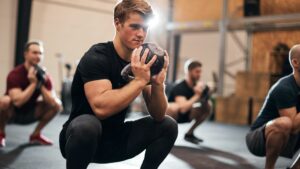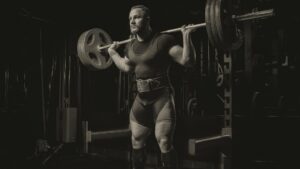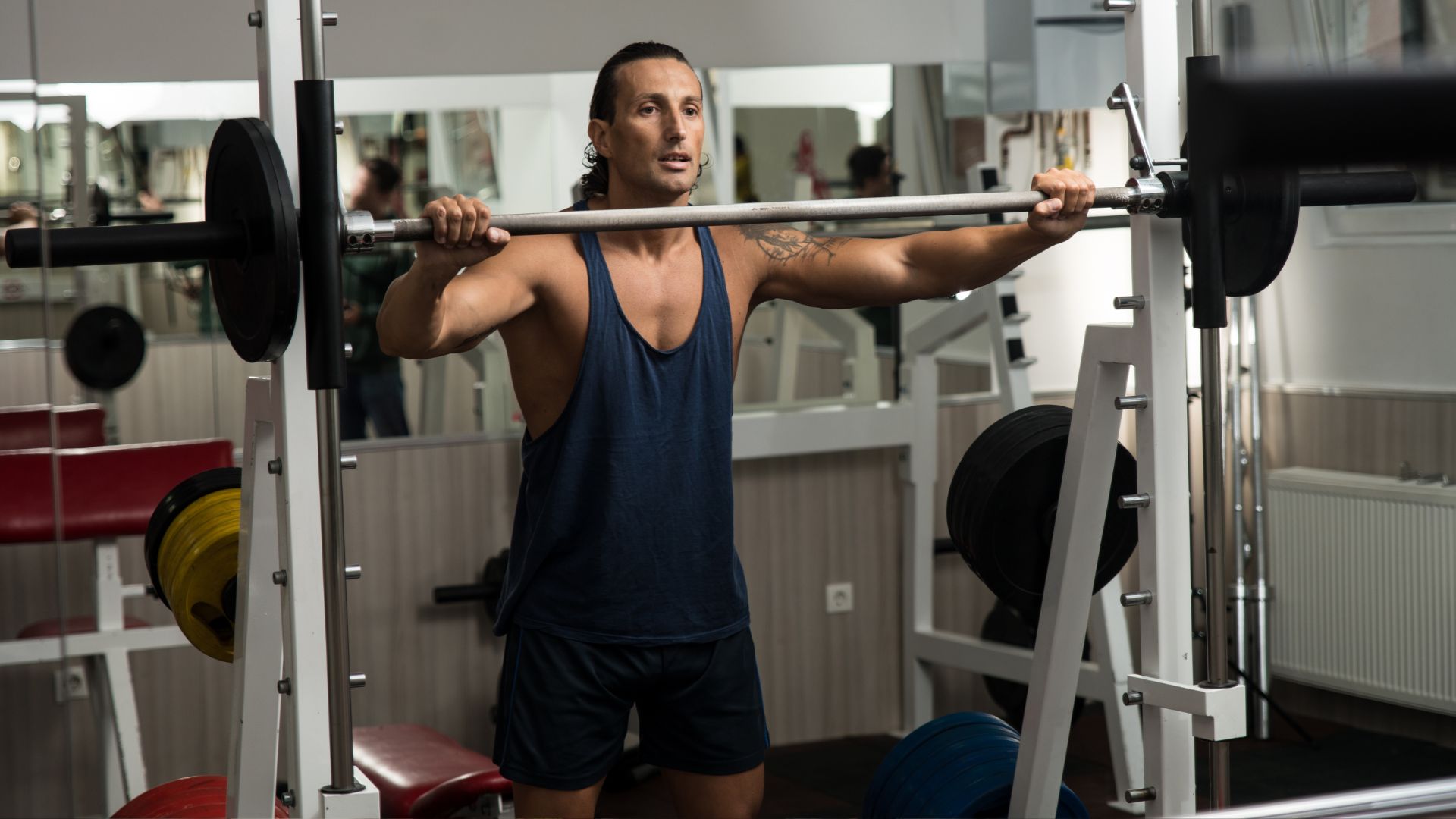Hey there, fitness enthusiasts! If you’ve ever wondered whether you should bother with clothing when hitting the squat rack, you’re not alone.
We’re diving into this seemingly simple yet surprisingly relevant question in today’s blog.
So, let’s strip away the confusion (figuratively, of course) and explore why what you wear matters when you’re getting your squat on. Stay tuned for all the insights!
Understanding whether to try to wear clothes when squatting.
Yes, it’s a good idea to wear appropriate clothing when doing squats. Here are some reasons why:
Comfort: Wearing the right clothing can make your squatting experience more comfortable. Loose or restrictive clothing may hinder your movement and make it harder to maintain proper form.
Safety: Wearing the right clothing can help prevent injuries. Loose or baggy clothing can get caught on equipment or hinder your range of motion, increasing the risk of accidents or strains.
Support: Proper workout attire, such as moisture-wicking materials or compression gear, can provide support to your muscles and reduce the risk of chafing or irritation.
Hygiene: Wearing clean workout clothes can help maintain good hygiene in the gym, which is important for both you and others using the same equipment.
Functionality: Consider wearing athletic shoes that provide good support and stability for your feet during squats.
These shoes are designed to help you maintain proper form and minimize the risk of injury.
In summary, while it’s not strictly necessary to wear specific clothing for squats, choosing appropriate workout attire can enhance your comfort, safety, and overall workout experience.

Further explanations
Let’s dive deeper and explain further the point mentioned here.
Let’s delve deeper into how clothing choice affects comfort and safety during squats:
Comfort:
Proper Form:
Wearing clothing that allows for a full range of motion is crucial for maintaining proper squat form.
Squats require bending at the hips and knees while keeping your back straight. Loose or tight clothing can restrict this movement and make it uncomfortable or even painful to perform squats correctly.
Breathability:
Sweating is common during squats, and wearing moisture-wicking fabrics can help keep you dry and comfortable.
These materials draw moisture away from your body, preventing discomfort and chafing caused by wet clothes.
Safety.
Reducing Risk of Accidents:
Loose or baggy clothing can get caught in gym equipment, such as the barbell or weight plates, while squatting. This can lead to accidents, such as tripping or falling, which can result in injuries.
Maintaining Balance:
Proper footwear is also essential for squat safety. Shoes with good grip and support can help you maintain balance and stability during the squat.
Inadequate footwear can increase the risk of slipping or losing your balance, potentially leading to strains or falls.
Preventing Overuse Injuries:
Wearing compression clothing or knee sleeves can provide extra support to your joints and muscles, helping to prevent overuse injuries like sprains or strains during squats.
In other words, wearing the right clothing during squats is essential for both comfort and safety.
It ensures that you can move freely, maintain proper form, and minimize the risk of accidents or injuries.
Choosing appropriate workout attire and footwear tailored to your specific needs can significantly enhance your squatting experience and overall gym performance.
let’s explore the importance of support and hygiene when it comes to choosing the right clothing for squats:
Support.
Muscle Support:
Compression gear, like compression shorts or leggings, can provide support to the muscles in your lower body, including the quadriceps, hamstrings, and calves.

This support can enhance blood circulation, reduce muscle vibration, and help prevent muscle fatigue or strain during squats.
Joint Support:
Some workout attire, particularly knee sleeves or wraps, can offer additional support to your knee joints.
Squats put significant stress on the knees, and these supportive accessories can help stabilize the joint, reducing the risk of injury.
Hygiene.
Cleanliness:
Gyms are shared spaces, and it’s essential to maintain good hygiene for yourself and others.
Wearing clean workout clothes ensures that you’re not introducing sweat, dirt, or odors to the gym environment.
Reducing Bacterial Growth:
Sweating is a natural part of physical activity, and moist clothing can become a breeding ground for bacteria.
Clean workout attire can help reduce the risk of skin irritations, rashes, or infections that may occur from prolonged exposure to bacteria on sweaty clothing.
In essence, wearing workout attire made of moisture-wicking materials and incorporating compression gear when needed can provide support to your muscles and joints during squats.
Additionally, maintaining cleanliness by wearing clean gym clothes is not only essential for your personal hygiene but also contributes to a healthier and more pleasant gym environment for everyone.
Let’s delve into the importance of functionality when it comes to choosing the right footwear for squats:
Functionality.
Athletic Shoes for Squats: Proper Foot Support:
Athletic shoes designed for weightlifting or strength training provide essential support to your feet during squats.
They often have a flat, stable sole that helps distribute your body weight evenly across your feet, which is crucial for maintaining balance and proper form during squats.
Heel Elevation:
Many weightlifting shoes have a slightly elevated heel. This heel lift can improve ankle mobility and allow for a more upright torso position during squats.
It can be particularly beneficial if you have limited ankle flexibility.
Grip and Stability:
These shoes typically have a non-slip sole that provides excellent traction, reducing the risk of slipping while lifting heavy weights.
This stability is vital for maintaining control during the squat movement.
Ankle Support:
Weightlifting shoes often have a high-top design or straps that provide extra ankle support. This can help stabilize your ankles, reducing the risk of rolling or injury.
Minimizing the Risk of Injury:
Proper footwear can significantly reduce the risk of injury during squats.
Inadequate footwear, such as running shoes with thick, cushioned soles, can lead to instability and compromise your ability to maintain proper form.
This may increase the risk of injuries, such as ankle twists, knee strains, or lower back discomfort.
In summary, wearing the right athletic shoes designed for weightlifting or strength training is crucial for functionality during squats.
These shoes provide essential support, stability, and traction, helping you maintain proper form and reducing the risk of injury.
Choosing appropriate footwear is a key component of a safe and effective squatting routine.
A concise tabular on this topic here.
Here’s a concise tabular summary on the topic of wearing clothes when doing squats:
| Aspect | Importance | Reasons |
|---|---|---|
| Comfort | High | 1. Loose or restrictive clothing can hinder movement and proper form.
2. Comfortable attire enhances the squatting experience. |
| Safety | High | 1. Loose or baggy clothing can get caught on equipment, increasing the risk of accidents.
2. Proper attire reduces the risk of strains and injuries. |
| Support | Moderate to High | 1. Compression gear can provide muscle and joint support.
2. Proper footwear offers stability and balance support. |
| Hygiene | Moderate to High | 1. Clean workout clothes maintain personal and gym hygiene.
2. Reduces the risk of skin issues and bacterial growth. |
| Functionality (Footwear) | High | 1. Weightlifting shoes offer proper foot support and stability.
2. They help maintain proper form and minimize injury risk. |
In summary, wearing appropriate clothing, including proper footwear, is crucial for comfort, safety, support, hygiene, and functionality when performing squats.
Conclusion.
In conclusion, wearing suitable clothing, including proper footwear, when doing squats is highly important.
It enhances comfort, safety, support, hygiene, and overall functionality during the exercise, ultimately contributing to a safer and more effective squatting experience.

Hey there, it’s Mike Rrsq, the Editor-in-Chief over at Jsquat.com, and I’m absolutely obsessed with all things squat fitness! I’ve been lucky enough to get some serious recognition for my work in this field. With a solid background in the fitness and wellness industry, I’ve been there right from the get-go, helping shape this website into what it is today.
You see, I’m not just the boss around here; I’m also a passionate contributor. I love sharing my insights through my articles, and trust me, they’re not your run-of-the-mill stuff. Each piece I write is a labor of love, filled with my expertise and real-world experience in the fitness universe. So, if you’re into fitness and looking for some inspiration, you’re in the right place!

